Can you name gay Japanese artists? Sadao Hasegawa, Gengoroh Tagame…and maybe one or two others. I couldn’t do much better than that before reading the fascinating books Gay Erotic Art in Japan, two volumes published in 2003 and 2006 by Japanese publisher Pot Publishing Co (the official page of the first volume is here, with samples), with texts in Japanese and in English.
The editor of these collections is, in fact, Gengoroh Tagame (I’m writing Japanese names in the Western order), one of the best-known Japanese gay artists, whose comics are full of burly guys hurting each other for love. In other words, he’s definitely in the S&M tradition that seems to pervade Japanese gay erotic art (I don’t know much about straight erotica art, but they obviously like bondage, too).
In the first book, which includes about 140 illustrations, Tagame writes a long introduction about the history of gay art in Japan, as well as biographical notes about each of the artists whose work is included in the book (about half a dozen in each of the two volumes). We learn that at the beginning of the 60s, before there was any gay magazine, gay-interest articles and illustrations were included in a magazine specializing in “abnormal” (we’d say “minority” nowadays, I guess) sexualities, including “S&M, fetishism, homosexuality, lesbianism and transvestism”–which could explain why so many early gay artists, and some current ones, drew S&M scenes, from light bondage to blood and torture. And then, there were members-only magazines, which means they had very small sales, like one called Bara (“rose”), whose name reappeared in the well-known Barazoku (“rose tribe”) magazine, from 1971 onwards.
As for earlier art, like the classical illustrations from before the XXth century, Tagame contends they aren’t really “gay” art, for reasons which show that he’s an essentialist–or at least, that’s how I understood them. Tagame also gives us the picture of a blend between Western influences (early Tom of Finland, Quaintance) and Japanese historical references (Samurai imagery, for example), with a balance depending on each artist. Tagame also discusses the subsequent evolution of gay magazines, and their increasing specializations, providing each of their twink-loving, bear-loving, S&M-loving readership with what they desired to see. He differentiates between two generations of gay artists, the first one drawing men with “a sorrowful look and a dark side”, while the second one moved from “spiritual beauty to physical bodies”. It’s a thorough analysis which seems the indicate that comparing the decades-long changes in gay erotic representations between Japan and the Western world can reveal interesting differences.
The second book is a direct continuation of the first one (and with even more illustrations), with Tagame’s introduction focusing on that second generation, which includes Sadao Hasegawa and Ben Kimura. He develops the way Western gay culture has influenced those second-generation artists, with the appearance of leather artifacts and sportsmen in their typical attire, from rugby shorts to jockstraps. Of course, Western culture, with its emphasis of bodily beauty–where, according to Tagame, Japan’s classical art displayed none of that–had already found a place in Japan from the end of the XIXth century, the Greek and Renaissance art becoming known at that time. Tagame also gives his readers a few ideas about the way self-inflicted homophobia influenced the way gay people in his country imagined themselves through art and history, and found a good opportunity to fantasize thanks to homosocial environments such as sports and the army. The details may differ, but worldwide gay male mentality does have its constants.
I’ll add that these two volumes are beautiful books: sturdy hardcovers, they’re presented in a slipcase, with a string signet and high quality reproductions. They’re not cheap, but they’re certainly worth it. Gengoroh Tagame indicates he’d like to do more books like that, so I hope he’ll have the opportunity to showcase more of his countrymen’s art. Some of them might do work which is too violent for me, but the general level of artistry throughout these books is absolutely incredible.
You can find both books at the Japanese online bookshop Rainbow Shoppers, here and here. If you live closer to France, you can find them at Les Mots à la Bouche, a Parisian gay bookshop, here and here.

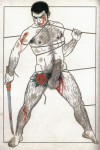
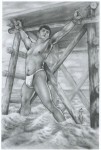
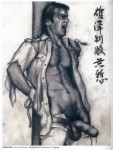
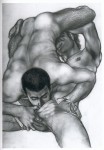
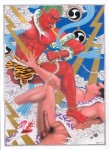


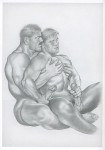
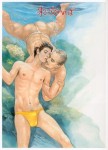
 Bluesky feed
Bluesky feed